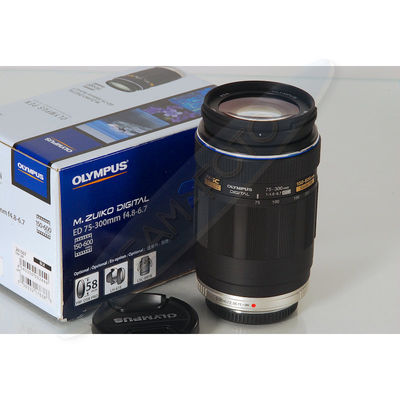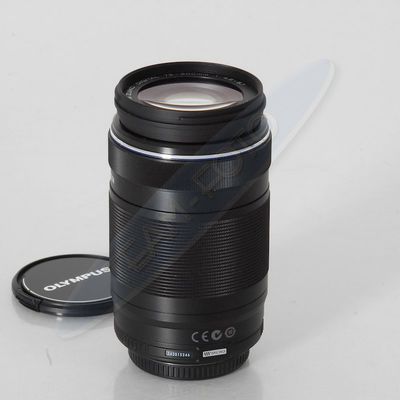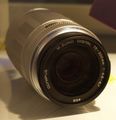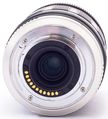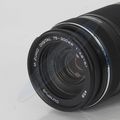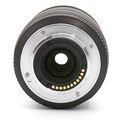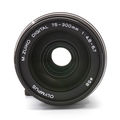M.ZUIKO DIGITAL ED 75-300mm F4.8-6.7: Unterschied zwischen den Versionen
K (Bilder, Links und Text eingefügt) |
K (Rebranding eingefügt) |
||
| (2 dazwischenliegende Versionen von 2 Benutzern werden nicht angezeigt) | |||
| Zeile 26: | Zeile 26: | ||
Hier ein paar Zitate aus dem [http://www.ephotozine.com/article/olympus-m-zuiko-ed-75-300mm-f-4-8-6-7-lens-review-18990 Test bei ephotozine]: | Hier ein paar Zitate aus dem [http://www.ephotozine.com/article/olympus-m-zuiko-ed-75-300mm-f-4-8-6-7-lens-review-18990 Test bei ephotozine]: | ||
:''"At 75mm, sharpness in the centre of the frame is limited, with the lens actually performing better towards the edges at all apertures. Sharpness across the frame is good at f/4.8 and improves to very good levels when stopped down to f/5.6."<br>"At 150mm, sharpness is excellent across the frame from maximum aperture and peak sharpness across the frame is achieved between f/5.6 and f/8."<br>"Finally at 300mm, sharpness levels drop a little, but they still just reach good levels across the frame at maximum aperture. Stopping down to f/8 results in peak sharpness for this focal length, with very good clarity in the centre."'' | :''"At 75mm, sharpness in the centre of the frame is limited, with the lens actually performing better towards the edges at all apertures. Sharpness across the frame is good at f/4.8 and improves to very good levels when stopped down to f/5.6."<br>"At 150mm, sharpness is excellent across the frame from maximum aperture and peak sharpness across the frame is achieved between f/5.6 and f/8."<br>"Finally at 300mm, sharpness levels drop a little, but they still just reach good levels across the frame at maximum aperture. Stopping down to f/8 results in peak sharpness for this focal length, with very good clarity in the centre."'' | ||
| + | |||
| + | Ein Zitat aus [https://robinwong.blogspot.com/2020/03/lens-talk-olympus-mzuiko-75-300mm-f48.html "Lens Talk: Olympus M.Zuiko 75-300mm F4.8-6.7 Mark II" in robinwong.blogspot.com]: | ||
| + | :''" The lens is made of 18 elements in 13 group construction, featuring 1 Super ED lens, 2 ED lenses and 3 HR lenses. Many have reported that they achieved sub-par images when shooting with the Olympus 75-300mm lens, and could not get anything sharp at full reach of 300mm. I find my experience to be the complete opposite, I did get beautifully sharp images all the way to 300mm full zoom. I admit, the best sharpness was achieved somewhere within the 75-200mm zoom range, and anything further than that, especially at the furthest end 300mm, there is a noticeable drop of overall sharpness, but the image output was far from soft, in fact it was still decently sharp, capturing plenty of useful fine detail, good contrast and overall clarity. I would not hesitate to go all the way to 300mm for the reach, and I was perfectly happy with my images at 300mm from the Olympus 75-300mm lens."<br>"Other aspects of image quality was nothing to write about, I did not notice any issue with chromatic aberration of pincushion distortion, perhaps both technical lens flaws were compensated and mitigated by software correction built into the camera. To me I do not care if it was the software that did some processing trick as long as I get good results free from such flaws, I am happy. Flare was well controlled, I did shoot against some strong source of light but did not see any problem with ghosting or flare. The Olympus 75-300mm Mark II lens does have ZERO coating from Olympus which resists flare quite effectively."'' | ||
== Technische Daten == | == Technische Daten == | ||
| Zeile 64: | Zeile 67: | ||
Olympus-Code: EZ-M7530-II | Olympus-Code: EZ-M7530-II | ||
| + | |||
==== Galerie ==== | ==== Galerie ==== | ||
Hier eine kleine Galerie mit Bildern des [[Objektiv]]s: | Hier eine kleine Galerie mit Bildern des [[Objektiv]]s: | ||
| Zeile 76: | Zeile 80: | ||
Bild:Olympus_mFT_75-300_Arsenal_9.jpg|M.ZUIKO DIGITAL ED 75-300mm F4.8-6.7 (Schwarz - Version II) - mit freundlicher Genehmigung von arsenal-photo.com | Bild:Olympus_mFT_75-300_Arsenal_9.jpg|M.ZUIKO DIGITAL ED 75-300mm F4.8-6.7 (Schwarz - Version II) - mit freundlicher Genehmigung von arsenal-photo.com | ||
</gallery> | </gallery> | ||
| + | |||
| + | === OM SYSTEM M.ZUIKO DIGITAL ED 75-300mm F4.8-6.7 II === | ||
| + | ==== Beschreibung ==== | ||
| + | Im Juli 2023 wurde das [[Objektiv]] ''M.ZUIKO DIGITAL ED 75-300mm F4.8-6.7 II'' abgekündigt und durch der ''OM SYSTEM M.ZUIKO DIGITAL ED 75-300mm F4.8-6.7 II'' ([https://asobinet.com/info-discon-m-zuiko-digital-ed-75-300mm-f4-8-6-7-ii-olympus/ Quelle]) ersetzt - folgende Änderungen sind bekannt: | ||
| + | * Wegfall der Gravur [[Olympus]] | ||
| + | * Neue Gravur '''OM SYSTEM''' | ||
| + | Es handelt es sich nur um ein "Re-Branding", weder die optische Rechnung, das Design oder die Fassung wurden verändert. | ||
== Lieferumfang == | == Lieferumfang == | ||
| − | * M.ZUIKO DIGITAL ED 75-300mm F4.8-6.7 bzw. M.ZUIKO DIGITAL ED 75-300mm F4.8-6.7 II (wahlweise in schwarz oder silber) | + | * M.ZUIKO DIGITAL ED 75-300mm F4.8-6.7 bzw. (OM SYSTEM) M.ZUIKO DIGITAL ED 75-300mm F4.8-6.7 II (wahlweise in schwarz oder silber) |
* [[Micro Four Thirds]] Objektivdeckel (LC-52C) | * [[Micro Four Thirds]] Objektivdeckel (LC-52C) | ||
* Hintere Objektivkappe für [[Micro Four Thirds]] Objektive (LR-2) | * Hintere Objektivkappe für [[Micro Four Thirds]] Objektive (LR-2) | ||
| Zeile 125: | Zeile 136: | ||
* [http://www.olympus.de/digitalkamera/zubehoer_m_zuiko_digital_ed_75-300mm_1_4_8-6_7_14469.htm Offizielle Produktseite von Olympus Deutschland] | * [http://www.olympus.de/digitalkamera/zubehoer_m_zuiko_digital_ed_75-300mm_1_4_8-6_7_14469.htm Offizielle Produktseite von Olympus Deutschland] | ||
* [http://www.ephotozine.com/article/olympus-m-zuiko-ed-75-300mm-f-4-8-6-7-lens-review-18990 Test bei ephotozine] (englisch) | * [http://www.ephotozine.com/article/olympus-m-zuiko-ed-75-300mm-f-4-8-6-7-lens-review-18990 Test bei ephotozine] (englisch) | ||
| + | * [https://robinwong.blogspot.com/2020/03/lens-talk-olympus-mzuiko-75-300mm-f48.html "Lens Talk: Olympus M.Zuiko 75-300mm F4.8-6.7 Mark II" in robinwong.blogspot.com] (englisch) | ||
== Beispielaufnahmen == | == Beispielaufnahmen == | ||
Aktuelle Version vom 1. August 2023, 20:29 Uhr
Beschreibung
Wird von Olympus unter PEN-Objektive geführt und als besonders kompaktes Tele-Zoom zum Fotografieren sowie als besonders leises Objektiv für Videoaufnahmen empfohlen.
d-pixx testete das Objektiv (in der ersten Variante) in Heft 1/2011 und gab ihm eine bessere Note als dem zum Vergleich getesteten Panasonic 100-300mm Objektiv.
Die Vignettierungen bei Offenblende können durch "leichtes Abblenden" (z.B. Blende 5.6 bei 75 mm oder Blende 8.0 bei 300 mm) stark reduziert werden, weiterhin können - trotz "elektronischem Eingriff" - ab ca. 150 mm Brennweite Farbsäume auftreten.
Die geringe Lichtstärke kann auch den Autofokus in Halbdunkel oder Dämmerlicht verlangsamen oder gar manuelle Fokuskorrektur erfordern.
Die zweite Varianten (II) soll - lt. Aussage von Olympus - optisch etwas besser sein, weiterhin wird sie auch etwas preiswerter angeboten.
Insgesamt ist aber festzustellen, dass es sich - auch bei der zweiten, verbesserten Variante - um ein Objektiv mit großem Brennweitenbereich handelt, welches (hierfür) relativ preiswert angeboten wird - daraus folgt aber ganz klar: Hierfür kann keine Spitzenleistung geboten werden, da große Kompromisse für diese Kombination erforderlich sind.
Deshalb muss es klar sein, dass das Objektiv an vergleichbare Festbrennweiten (und natürlich die - wesentlich teureren - Objektive der "Pro-Reihe") nicht herankommt. Sucht man Spitzenleistung, so ist man hier an der falschen Adresse.
Insbesondere das Bokeh ist - gelinde gesagt - "gewöhnungsbedürftig", die Auflösung entspricht auch nicht den Anforderungen des 16-MP-Sensors. Hier helfen auch die "elektronischen Eingriffe" der Kameras nicht weiter.
Wie auch bei allen "Nicht-Pro-Objektiven" von Olympus ist die Streulichtblende (LH-61E) nicht im Lieferumfang enthalten, weiterhin ist sie auch recht teuer. Es gibt aber "kompatible" Produkte von diversen Fremdherstellern, die deutlich preiswerter angeboten werden, es kann aber auch - ohne Probleme - eine "Einschraubblende" für Teleobjektive genutzt werden.
Zitate
Ein Zitat aus dem Vergleich mit dem Panasonic 100-300 (Teil 2) in pen-and-tell.blogspot.de:
- "...in der Abbildungsqualität gibt es Unterschiede: die chromatischen Aberrationen des Panasonic sind härter und auffallender. Die Auflösung beider Objektive liegt auf gleichem Niveau, das Panasonic ist aber kontrastreicher, schärfer abgestimmt. Es wirkt knackiger."
"Auch bei der Dynamik hat das Zuiko die Nase vorn: extreme Kontraste kann das Zuiko besser ab als das Panasonic, das dann in kritischen Situationen schon mal für ausgefressene Lichter sorgt."
"Fazit: auch wenn das Panasonic auf den ersten Blick das gefälligere, weil konstraststärkere Objektiv zu sein scheint: im praktischen Betrieb erfreut das Zuiko mit der ausgewogeneren Abbildung, weniger Fehlern und kompakteren Abmessungen. Dazu einem besser regelbaren manuellem Fokus und geringerer Streulichtempfindlichkeit - trotz Verzicht auf die Streulichtblende. Nicht zu unterschätzen sind die 25 mm "mehr" am kurzen Ende, die bisweilen den Unterschied zwischen Objektiv drauflassen und Objektiv wechseln ausmachen."
Hier ein paar Zitate aus dem Test bei ephotozine:
- "At 75mm, sharpness in the centre of the frame is limited, with the lens actually performing better towards the edges at all apertures. Sharpness across the frame is good at f/4.8 and improves to very good levels when stopped down to f/5.6."
"At 150mm, sharpness is excellent across the frame from maximum aperture and peak sharpness across the frame is achieved between f/5.6 and f/8."
"Finally at 300mm, sharpness levels drop a little, but they still just reach good levels across the frame at maximum aperture. Stopping down to f/8 results in peak sharpness for this focal length, with very good clarity in the centre."
Ein Zitat aus "Lens Talk: Olympus M.Zuiko 75-300mm F4.8-6.7 Mark II" in robinwong.blogspot.com:
- " The lens is made of 18 elements in 13 group construction, featuring 1 Super ED lens, 2 ED lenses and 3 HR lenses. Many have reported that they achieved sub-par images when shooting with the Olympus 75-300mm lens, and could not get anything sharp at full reach of 300mm. I find my experience to be the complete opposite, I did get beautifully sharp images all the way to 300mm full zoom. I admit, the best sharpness was achieved somewhere within the 75-200mm zoom range, and anything further than that, especially at the furthest end 300mm, there is a noticeable drop of overall sharpness, but the image output was far from soft, in fact it was still decently sharp, capturing plenty of useful fine detail, good contrast and overall clarity. I would not hesitate to go all the way to 300mm for the reach, and I was perfectly happy with my images at 300mm from the Olympus 75-300mm lens."
"Other aspects of image quality was nothing to write about, I did not notice any issue with chromatic aberration of pincushion distortion, perhaps both technical lens flaws were compensated and mitigated by software correction built into the camera. To me I do not care if it was the software that did some processing trick as long as I get good results free from such flaws, I am happy. Flare was well controlled, I did shoot against some strong source of light but did not see any problem with ghosting or flare. The Olympus 75-300mm Mark II lens does have ZERO coating from Olympus which resists flare quite effectively."
Technische Daten
| Hersteller: | Olympus | Bezeichnung: | M.Zuiko Digital ED 75-300mm 1:4.8-6.7 | |||||||||
|---|---|---|---|---|---|---|---|---|---|---|---|---|
| Brennweite: | 75-300 mm | Herstellungszeitraum: | 2008 - 2013 | |||||||||
| Lichtstärke: | 4,8-6,7 | Blendenbereich: | 22 | |||||||||
| Baulänge: | 116 mm | Durchmesser: | 70 mm | |||||||||
| Gewicht: | 430 g | Filtergewinde: | 58 mm | |||||||||
| Min. Entfernung: | 0,9 m | Max. Abbildungsm.: | ||||||||||
| Bajonett: | micro FT | Spritz-/Staubschutz: | nein | Bildstabilisator: | nein | |||||||
| Bildwinkel: | 16-4,1° | Linsen/Baugruppen: | 18/13 | Blendenaufbau: | 7 (kreisförmig) | |||||||
| Innenfokussierung: | ja | Geradführung: | Innenzoom: | |||||||||
| AF-Antrieb: | Fokussierung: | Zoom: | ||||||||||
| Besonderheiten: | "Durch den internen Fokusmechanismus mit Schraubgewinde werden beim Fokussieren weniger Einheiten bewegt. Das Ergebnis: ein schneller Kontrast-AF und leise Objektivbewegungen" [orig.Text Olympus] | |||||||||||
Varianten
Es sind folgende Varianten bekannt - einen Vergleich der beiden Versionen finden Sie hier auf pen-and-tell.blogspot.de:
M.ZUIKO DIGITAL ED 75-300mm F4.8-6.7
Beschreibung
Die "Ursprungsvariante" wurde im September 2008 vorgestellt und wurde mit einer unverbindlichen Preisempfehlung von 899€ gelistet.
Olympus-Code: EZ-M7530
Galerie
Hier eine kleine Galerie mit Bildern des Objektivs:
M.ZUIKO DIGITAL ED 75-300mm F4.8-6.7 II
Beschreibung
Im Januar 2013 wurde diese Variante vorgestellt. Inwieweit sie sich - intern - von der "Ursprungsvariante" abweicht, ist nicht bekannt, hier die "offensichtlichen Unterschiede" (die Daten der "Ursprungsvariante" in Klammern):
- Durchmesser 69 mm (70 mm)
- Länge 116,5 mm (116 mm)
- Gewicht 423 Gramm (430 Gramm)
Weiterhin weicht das Design ab - siehe hierzu die Beispielbilder im Artikel.
Die unverbindliche Preisempfehlung wurde von Olympus aber auf 549€ gesenkt.
Olympus-Code: EZ-M7530-II
Galerie
Hier eine kleine Galerie mit Bildern des Objektivs:
M.ZUIKO DIGITAL ED 75-300mm F4.8-6.7 (Schwarz - Version II) und Gegenlichtblende "LH-61E" - mit freundlicher Genehmigung von arsenal-photo.com
OM SYSTEM M.ZUIKO DIGITAL ED 75-300mm F4.8-6.7 II
Beschreibung
Im Juli 2023 wurde das Objektiv M.ZUIKO DIGITAL ED 75-300mm F4.8-6.7 II abgekündigt und durch der OM SYSTEM M.ZUIKO DIGITAL ED 75-300mm F4.8-6.7 II (Quelle) ersetzt - folgende Änderungen sind bekannt:
- Wegfall der Gravur Olympus
- Neue Gravur OM SYSTEM
Es handelt es sich nur um ein "Re-Branding", weder die optische Rechnung, das Design oder die Fassung wurden verändert.
Lieferumfang
- M.ZUIKO DIGITAL ED 75-300mm F4.8-6.7 bzw. (OM SYSTEM) M.ZUIKO DIGITAL ED 75-300mm F4.8-6.7 II (wahlweise in schwarz oder silber)
- Micro Four Thirds Objektivdeckel (LC-52C)
- Hintere Objektivkappe für Micro Four Thirds Objektive (LR-2)
- Garantieunterlagen und Bedienungsanleitung
Tests und Bewertungen
Zur Einschätzung des Objektivs einige vergleichende Wertungen von DXOmark (jeweils an einer Olympus E-M1 OM-D):
| Objektiv | DxOMark Score | Sharpness | Transmission | Distortion | Vignetting | Chr. aberration |
| Olympus M.ZUIKO DIGITAL ED 75-300mm F4.8-6.7 | 10 | 5 MP | F6.0 | 0.3% | -0.7EV | 12µm |
| Olympus M.ZUIKO DIGITAL ED 75-300mm F4.8-6.7 II | 12 | 6 MP | F5.7 | 0.3% | -0.7EV | 9µm |
| Panasonic LUMIX G VARIO 100-300mm f/4-5.6 MEGA O.I.S. | 12 | 5 MP | F5.1 | 0.1% | -1.0EV | 8µm |
Weblinks
- Vergleichstest der Versionen I, II in pen-and-tell.blogspot.de
- Vergleich mit dem Panasonic 100-300 (Teil 1) in pen-and-tell.blogspot.de
- Vergleich mit dem Panasonic 100-300 (Teil 2) in pen-and-tell.blogspot.de
- Offizielle Produktseite von Olympus Deutschland
- Test bei ephotozine (englisch)
- "Lens Talk: Olympus M.Zuiko 75-300mm F4.8-6.7 Mark II" in robinwong.blogspot.com (englisch)
Beispielaufnahmen

Weißhandgibbon Zoologischer Garten Wuppertal - (Vollbild, nicht verkleinert), M.ZUIKO DIGITAL ED 75-300mm F4.8-6.7 (Version II), OM-D E-M10, Blende 6.7, Brennweite 300mm
Kalifornischer Seelöwe Zoologischer Garten Wuppertal - (Vollbild, nicht verkleinert), M.ZUIKO DIGITAL ED 75-300mm F4.8-6.7 (Version II), OM-D E-M10, Blende 5.6, Brennweite 100mm
Katta Zoo Duisburg - (Vollbild, nicht verkleinert), M.ZUIKO DIGITAL ED 75-300mm F4.8-6.7 (Version II), OM-D E-M10, Blende 6.4, Brennweite 240mm
Katta Zoo Duisburg - (Vollbild, nicht verkleinert), M.ZUIKO DIGITAL ED 75-300mm F4.8-6.7 (Version II), OM-D E-M1, Blende 6.7, Brennweite 300mm
Ente Zoo Duisburg - (Vollbild, nicht verkleinert), M.ZUIKO DIGITAL ED 75-300mm F4.8-6.7 (Version II), OM-D E-M1, Blende 5.6, Brennweite 150mm
Trappe Zoo Duisburg - (Vollbild, nicht verkleinert), M.ZUIKO DIGITAL ED 75-300mm F4.8-6.7 (Version II), OM-D E-M1, Blende 6.7, Brennweite 250mm
Fischotter Zoo Duisburg - (Vollbild, nicht verkleinert), M.ZUIKO DIGITAL ED 75-300mm F4.8-6.7 (Version II), OM-D E-M1, Blende 6.8, Brennweite 300mm
Paviane Zoo Krefeld - (Vollbild, nicht verkleinert), M.ZUIKO DIGITAL ED 75-300mm F4.8-6.7 (Version II), PEN E-PL6, Blende 5.6, Brennweite 140mm
Bitte beachten:
Die tatsächliche Darstellung von Bokeh, Schärfe, Kontrast, Schärfentiefe etc. treten erst bei der Betrachtung in "Vollauflösung" in Erscheinung, hierzu wurden viele Bildbeispiele in Originalgröße (aber stark komprimiert) hinterlegt.

